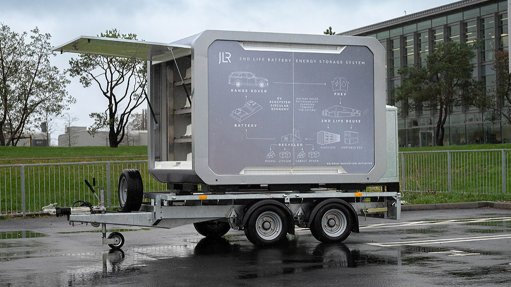South African space agency aims to select earth observation satellite design this year
The South African National Space Agency (Sansa) expects to make key decisions on the design of its next earth observation satellite in July. “The satellite programme is going well,” reports Sansa CEO Dr Sandile Malinga. “We will have a scheduled system requirement review in July, at which Denel Spaceteq will present its proposals. They’re working on the engineering side of things – on the design.” (Stellenbosch-based Spaceteq took over the assets and many of the personnel of insolvent company Sun Space & Information Systems, which designed and built Sansa’s previous earth observation satellite, Sumbandila.)
“We’ve looked at a number of design options,” he adds. “We need to now select one, determined by affordability, technical factors and risk factors. We want it to last five to seven years, so we need to look at redundancy – [duplicating key systems as insurance against failures]. That requires trade-offs with other capabilities – fewer experiments on the satellite, but longer life. We hope to launch it by 2018.”
Sansa undertook a thorough examination of the requirements of the various government department and agencies that would use the imagery acquired by the satellite. This process appeared to be almost completed by the end of 2012, but budgetary constraints forced Sansa to ask the intended users to relook at their requirements and narrow the scope of their requirements.
The result has been that the mission for the new satellite has been recategorised into three tiers. The primary mission will be to observe the status of vegetation. This capability will be very important in terms of monitoring agriculture (both arable and, through observing grazing lands, livestock) and forestry, as well as the terrestrial environment. This will be of great benefit in terms of food security, for example. “For the secondary mission, we are looking at how to use the satellite for planning and monitoring service delivery, as well as monitoring disasters,” he states. The spacecraft’s tertiary role will be the fulfillment of various ancillary missions, including observing atmospheric conditions.
This satellite programme is not being funded out of the Sansa core (or base) budget, but is a direct and ringfenced allocation from government. The amount to be allocated for the satellite programme and space industry upgrade for this financial year (2014/15, which started on April 1) is being finalised.
Regarding the agency’s base budget, this year, it is 6% higher than that in the previous year (2013/14). But, once inflation is taken into account, that amounts to a slight cut in real terms. “This will impinge on our programmes,” acknowledges Malinga. “Our aim is to diversify our income streams. We are going to engage more with the rest of public sector to get them to share some of the costs we are carrying.” Many government departments and agencies make use of satellite imagery obtained and processed by Sansa. But the cost of all this imagery and analysis is borne entirely by the Department of Science and Technology and, indirectly, by Sansa. “That puts pressure on other priority areas of the department and the agency. We need a better funding model. The aim is not to make a profit but to share costs and find a sustainable way of providing this essential service to the public sector.”
Nevertheless, the agency continues to improve the services it offers its clients. It has signed up to receive imagery from the Airbus Defence and Space Spot 6 Earth observation satellite. Launched in 2012, this provides a resolution of 1.5 m while retaining a 60-km-wide imaging swathe. The previous Spot 5 used by Sansa has a resolution of between 2.5 m and 5 m. The local agency is now also receiving imagery from the US Geological Survey’s Landsat 8, launched in May 2013.
Comments
Press Office
Announcements
What's On
Subscribe to improve your user experience...
Option 1 (equivalent of R125 a month):
Receive a weekly copy of Creamer Media's Engineering News & Mining Weekly magazine
(print copy for those in South Africa and e-magazine for those outside of South Africa)
Receive daily email newsletters
Access to full search results
Access archive of magazine back copies
Access to Projects in Progress
Access to ONE Research Report of your choice in PDF format
Option 2 (equivalent of R375 a month):
All benefits from Option 1
PLUS
Access to Creamer Media's Research Channel Africa for ALL Research Reports, in PDF format, on various industrial and mining sectors
including Electricity; Water; Energy Transition; Hydrogen; Roads, Rail and Ports; Coal; Gold; Platinum; Battery Metals; etc.
Already a subscriber?
Forgotten your password?
Receive weekly copy of Creamer Media's Engineering News & Mining Weekly magazine (print copy for those in South Africa and e-magazine for those outside of South Africa)
➕
Recieve daily email newsletters
➕
Access to full search results
➕
Access archive of magazine back copies
➕
Access to Projects in Progress
➕
Access to ONE Research Report of your choice in PDF format
RESEARCH CHANNEL AFRICA
R4500 (equivalent of R375 a month)
SUBSCRIBEAll benefits from Option 1
➕
Access to Creamer Media's Research Channel Africa for ALL Research Reports on various industrial and mining sectors, in PDF format, including on:
Electricity
➕
Water
➕
Energy Transition
➕
Hydrogen
➕
Roads, Rail and Ports
➕
Coal
➕
Gold
➕
Platinum
➕
Battery Metals
➕
etc.
Receive all benefits from Option 1 or Option 2 delivered to numerous people at your company
➕
Multiple User names and Passwords for simultaneous log-ins
➕
Intranet integration access to all in your organisation


















